Pump and System Basics
Submersible
(Below the water)

Residential Well Pumps
These pumps are the majority of water pumping systems for homes. They can vary in Horsepower ratings from ½ HP up to sometimes 10 HP, but these are rare instances. What most people don’t know is that a well pump is actually made up of 2 different pieces, the motor and pump. In 95% of cases, we change both pieces when replacing someone’s submersible pump simply because one side (the motor or the pump) has the capability of destroying the other side and vice versa.
Sewage or Trash Pumps
These have a variety of uses pumping water from large drainage systems, such as in parking lots or used as a sump pump from a basement of a home. They come in all shapes and sizes, different voltages and can handle different amounts of “Particulate” or substances within the liquid. As the name implies, they are often used in sewage plants or in very dirty water where they pass lots of “stuff” through them without harm to the pump itself.
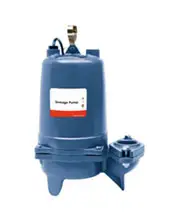
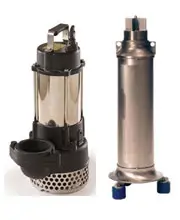
Typical Pumps for Waterfalls
As the name implies, these pumps are typically found in water features or waterfalls. They can be very similar to sewage pumps or look like a submersible pump. We’ve seen water features plumbed with just about everything depending on the application and where the water might be coming from. The key to a good waterfall or water feature is to plan it correctly the first time and have us determine what kind of pump you can use given your conditions. It’s not as simple as it seems so let the experts handle it and do it right the first time.
Centrifugal
(Above ground)
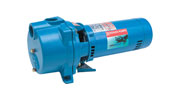
Typical Residential Irrigation Pump
Many Homeowners use irrigation pumps to water everything from landscapes around a home to crops, fields and pastures. Here at Burgess, when we refer to an “irrigation” pump, we are meaning and above ground or “centrifugal” pump. They can come in many flavors and are usually from ½ HP (Horsepower) on up to about 10 HP for residential use. Irrigation pumps should be maintained regularly and many can be rebuilt once they start to go bad. Of course, starting with a quality product usually means a rebuild is possible while inferior products do not offer replacement parts and are simply “throw-aways”. Higher end products manufactured by Berkeley, Sta-Rite, Goulds and Munro tend to need adjustments and packing to ensure they operate to full efficiency. This should be done each year at the start of water season. The higher quality pumps use cast iron cases, either stainless or brass impellers, and high quality, name brand motors which are replaceable and/or repairable. Low quality products use plastic parts and plastic impellers with no name or foreign motors. Initially, the performance ratings may be similar, however after a short time, the lower end pumps tend to perform worse while the higher end models remain consistant. With irrigation pumps, since they sit above ground, they do need winterization.
Typical Residential “Jet” Pump
Jet Pumps mimic centrifugal/irrigation pumps but they differ in that they create a larger amount of pressure (enough for household use) using a venturi. Jet pumps need priming and cannot draw water from depths lower than about 30ft. from the surface. This is why they are referenced as being for “shallow wells” only. Here in Idaho, many areas have water tables as high as a few feet and some have “Flowing or Artesian” wells where the water has pressure directly from the earth and will flow water over the top of a well casing if not stopped using a well seal. The main advantage to using a Jet pump is cost. They are typically less expensive to install and replace but they also come with a host of drawbacks. They can only produce 12-15 gallons per minute of water at the most and they only go up to 1-1/2 HP. Jet pumps can be prone to freezing since they exist above ground so they must be kept warm enough and pass enough water through them in the winter to prevent a total shut down.
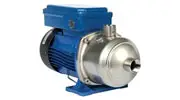

Commercial Centrifugal (Or Irrigation) Pumps
Simply put, these pumps are labeled more “Agricultural” or for “Commercial Use” because they are typically higher in horsepower and can pump lots and lots of water that a typical homeowner wouldn’t need. They can be used to drive wheel lines, pivots or even within commercial machinery driving chemicals through a plant. We even have a local car wash that uses several to operate the wash jets and water recovery systems for the car washes we all enjoy. Their uses are endless and they can be made specific to your application. The good news is that they are usually repairable as the cost to replace them can sometimes be quite high.
Centrifugal Waterfall Pump
One more type of pump we see is the above ground “waterfall” pump. Yes, most are usually submersed, however, sometimes, the water source is such that a pump of this nature has to be used. As you know, waterfalls have lots of water gushing out and over them. The pumps job is to recycle that water over and over again. If the catch basin for the recycled water is too shallow, or is unable to have a pump submersed into it, then we need another way to pump the water, hence the centrifugal waterfall pump. These mimic pool pumps and some people have actually used a pool pump for this purpose.

Basic Control & System Types
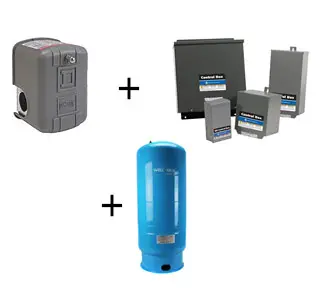
Pressure Switch + Control Box + Large Tank
People who have been on a well for a while know this type of control system. There’s a pressure control switch that exists in your plumbing that is wired either directly to your pump (in a 2 wire system) or through a control box (3 wire system). We term these type of systems as “Bang On / Bang Off” systems. In essence, when the pressure in your water system drops below a certain threshold, say 40 psi, “Bang” the pressure switch trips and tells the pump to start. Once the pressure in the lines builds up to say, 60 psi, “Bang”, the pressure switch trips which tells the pump to stop. This process goes on all day unless no one is using water, which, theoretically, the systems pressure remains constant and the system remains off.
Constant Pressure Drive (VFD) + Typically Small Tank
In today’s technology, many pumps are controlled with Variable Frequency Drives (VFD’s) rather than the old pressure switch systems of the past. A VFD system uses an electronic drive to control the electricity supplied to the pumps motor and senses pressure through the use of a pressure transmitter or “transducer” that is connected to the homes plumbing. With the use of a drive, pressure changes are handled by speeding up the pumps motor or slowing it down depending on the demand which gives you a more constant pressure, hence the term, “Constant Pressure System”. This technology is used throughout residential, agricultural and commercial systems of all sorts and can be “retrofitted” into the typical pressure switch system.
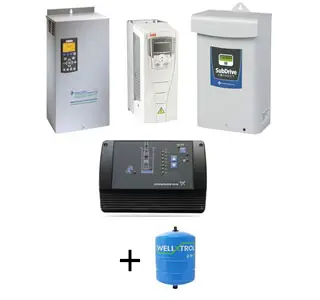
The “Pro’s” and “Con’s” of Each
In today’s technology, many pumps are controlled with Variable Frequency Drives (VFD’s) rather than the old pressure switch systems of the past. A VFD system uses an electronic drive to control the electricity supplied to the pumps motor and senses pressure through the use of a pressure transmitter or “transducer” that is connected to the homes plumbing. With the use of a drive, pressure changes are handled by speeding up the pumps motor or slowing it down depending on the demand which gives you a more constant pressure, hence the term, “Constant Pressure System”. This technology is used throughout residential, agricultural and commercial systems of all sorts and can be “retrofitted” into the typical pressure switch system.
